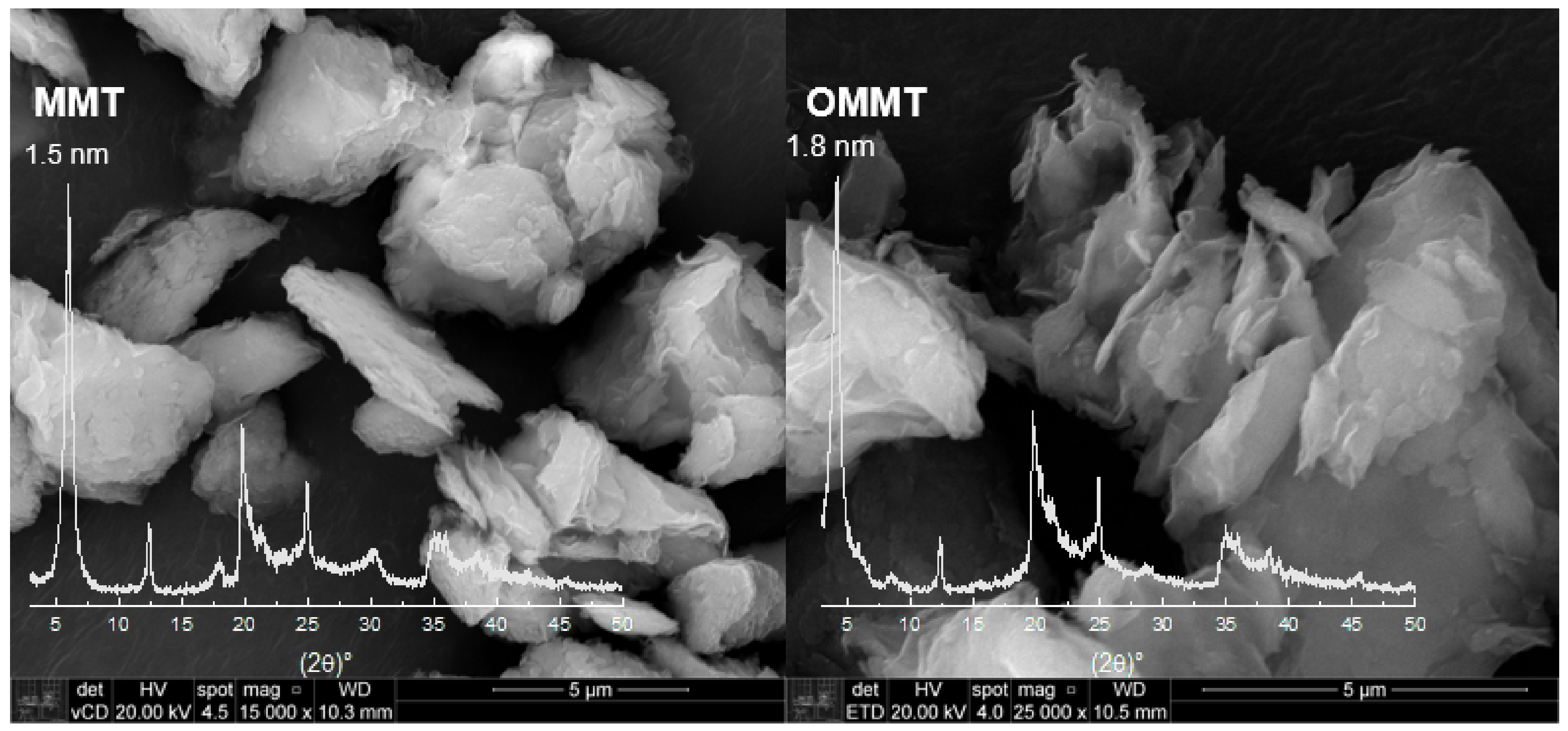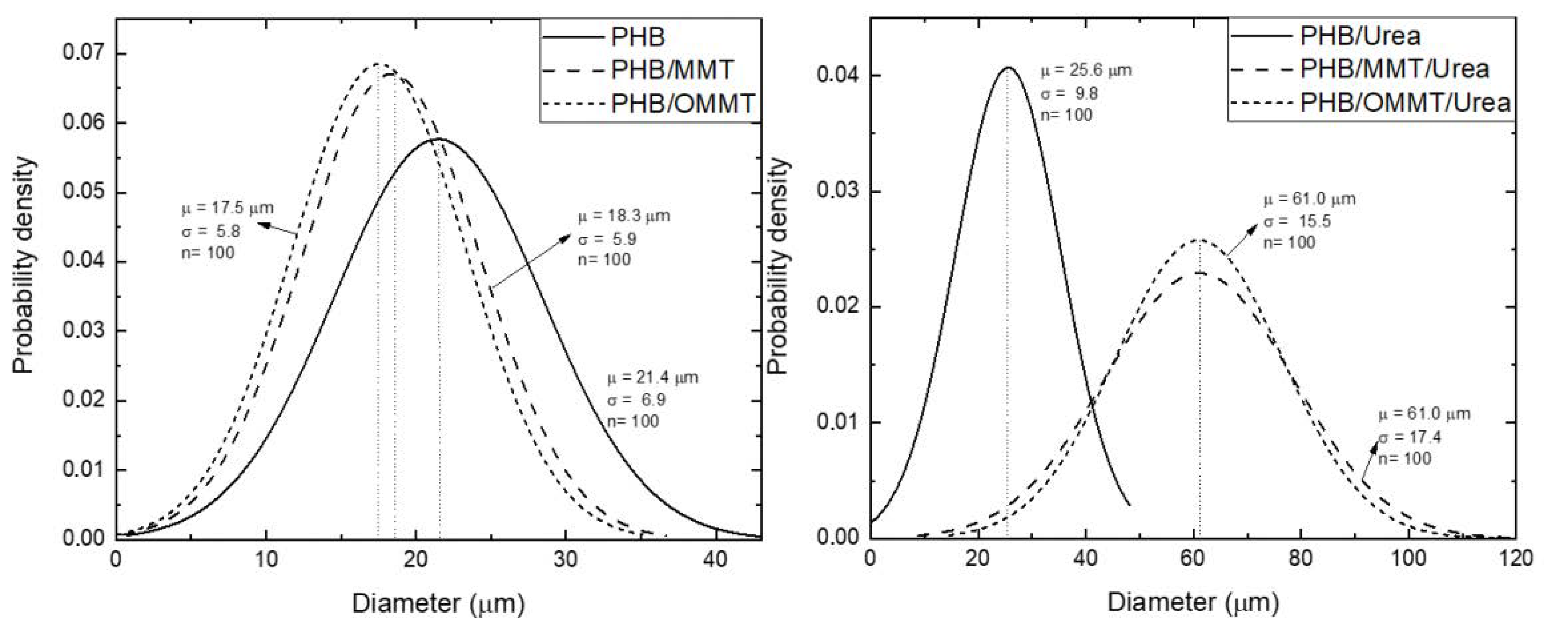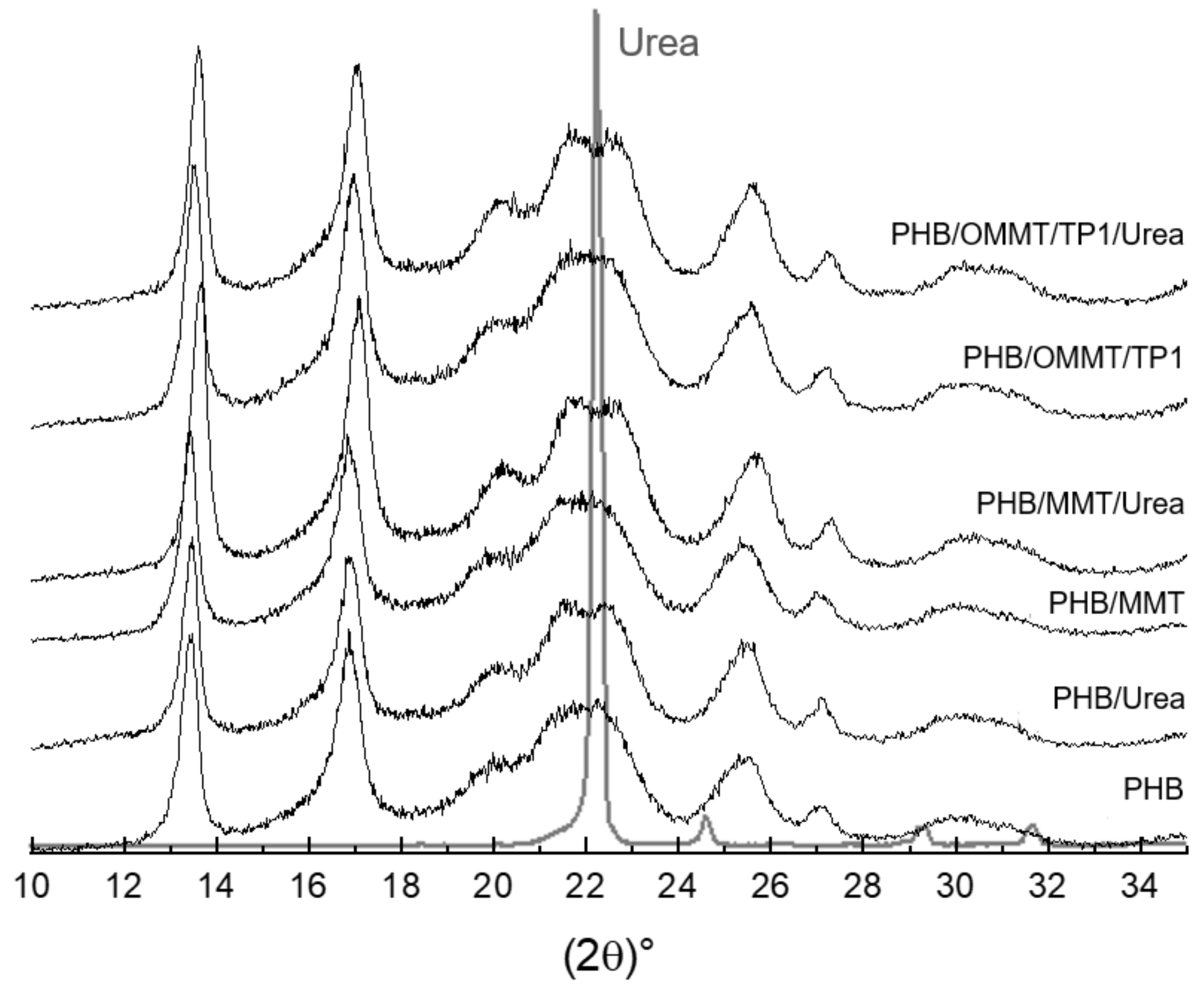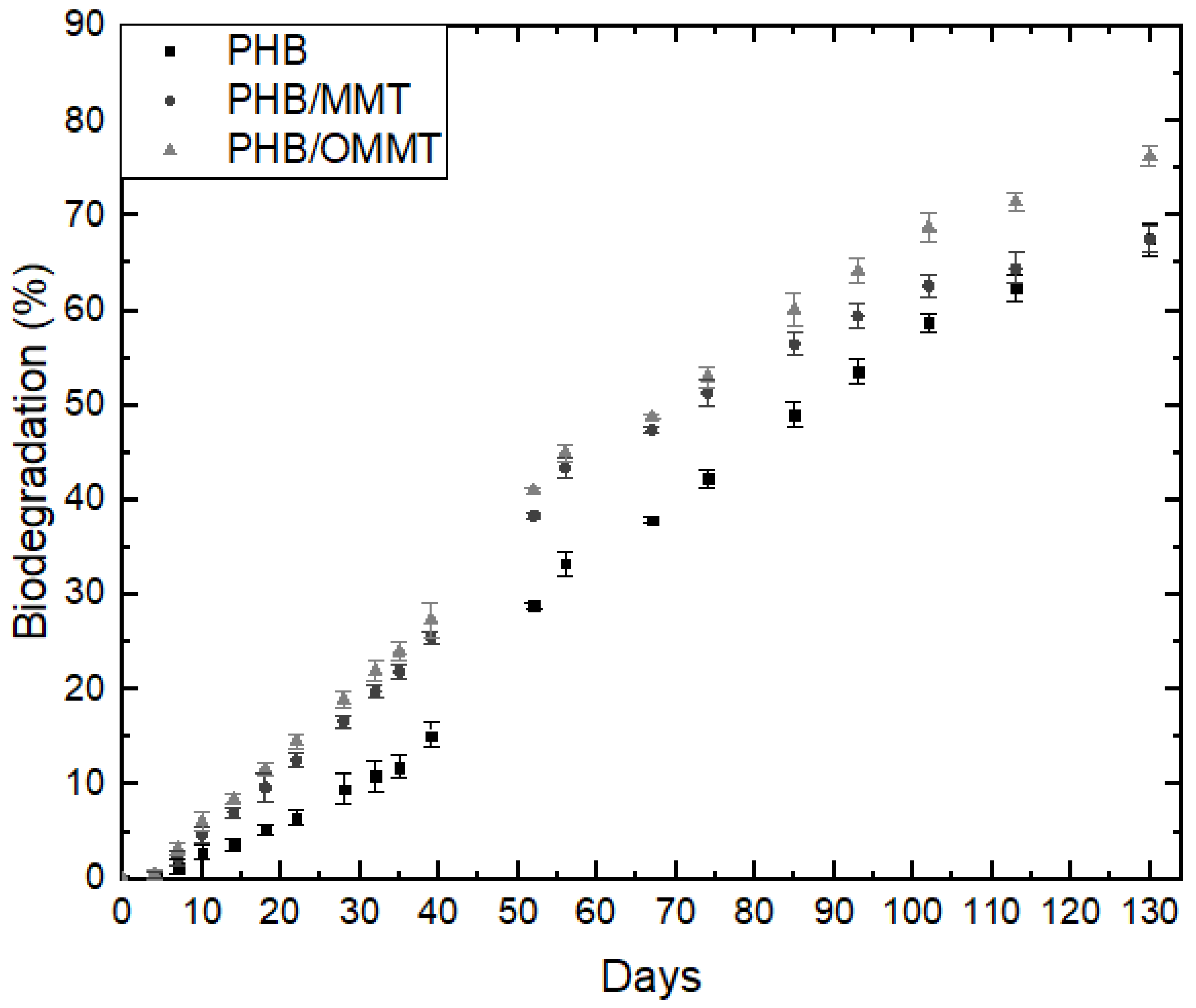Biodegradable Nanocomposite Microcapsules for Controlled Release of Urea
Abstract
1. Introduction
2. Materials and Methods
2.1. Materials
2.2. Methods
2.2.1. Clay Purification
2.2.2. Clay Organofilization
2.2.3. Preparation of Nanocomposite Dispersions
2.2.4. Preparation of Microcapsules
2.3. Characterizations
2.3.1. X-ray Diffractometry (XRD)
2.3.2. ATR-FTIR Spectroscopy (FTIR)
2.3.3. Scanning Electron Microscopy (SEM)
2.3.4. Atomic Force Microscopy (AFM)
2.3.5. Thermogravimetric Analysis (TGA)
2.3.6. Biodegradation Test (ASTM 5988-92)
3. Results
3.1. Clays
3.2. Microcapsules’ Crystallinity
3.3. Encapsulation of Urea in Microcapsules
3.4. Microcapsules’ Biodegradation
4. Conclusions
Supplementary Materials
Author Contributions
Funding
Institutional Review Board Statement
Informed Consent Statement
Data Availability Statement
Acknowledgments
Conflicts of Interest
References
- Araújo, B.R.; Romão, L.P.C.; Doumer, M.E.; Mangrich, A.S. Evaluation of the interactions between chitosan and humics in media for the controlled release of nitrogen fertilizer. J. Environ. Manag. 2017, 190, 122–131. [Google Scholar] [CrossRef]
- Daitx, T.S.; Giovanela, M.; Carli, L.N.; Mauler, R.S. Biodegradable polymer/clay systems for highly controlled release of NPK fertilizer. Polym. Adv. Technol. 2019, 30, 631–639. [Google Scholar] [CrossRef]
- Masunga, R.H.; Uzokwe, V.N.; Mlay, P.D.; Odeh, I.; Singh, A.; Buchan, D.; de Neve, S. Nitrogen mineralization dynamics of different valuable organic amendments commonly used in agriculture. Appl. Soil Ecol. 2016, 101, 185–193. [Google Scholar] [CrossRef]
- Da Costa, T.P.; Westphalen, G.; Nora, F.B.D.; Silva, B.d.; da Rosa, G.S. Technical and environmental assessment of coated urea production with a natural polymeric suspension in spouted bed to reduce nitrogen losses. J. Clean. Prod. 2019, 222, 324–334. [Google Scholar] [CrossRef]
- Jiang, X.; Zhang, M.; Yan, B.; Hu, J.; Chen, J.; Guan, Y. Roles of Mg-Al Layered Double Hydroxides and Solution Chemistry on P Transport in Soil. Chem. Eng. J. 2019, 373, 1111–1119. [Google Scholar] [CrossRef]
- Qiao, D.; Liu, H.; Yu, L.; Bao, X.; Simon, G.P.; Petinakis, E.; Chen, L. Preparation and characterization of slow-release fertilizer encapsulated by starch-based superabsorbent polymer. Carbohydr. Polym. 2016, 147, 146–154. [Google Scholar] [CrossRef] [PubMed]
- Yu, X.; Li, B. Release mechanism of a novel slow-release nitrogen fertilizer. Particuology 2019, 45, 124–130. [Google Scholar] [CrossRef]
- Wei, H.; Wang, H.; Chu, H.; Li, J. Preparation and characterization of slow-release and water-retention fertilizer based on starch and halloysite. Int. J. Biol. Macromol. 2019, 133, 1210–1218. [Google Scholar] [CrossRef] [PubMed]
- Mushtaq, A.; Rizwan, S.; Jamil, N.; Ishtiaq, T.; Irfan, S.; Ismail, T.; Malghani, M.N.; Shahwani, M.N. Influence of silicon sources and controlled release fertilizer on the growth of wheat cultivars of Balochistan under salt stress. Pak. J. Bot. 2019, 51, 1561–1567. [Google Scholar] [CrossRef]
- Santos, B.R.D.; Bacalhau, F.B.; Pereira, T.D.S.; Souza, C.F.; Faez, R. Chitosan-montmorillonite microspheres: A sustainable fertilizer delivery system. Carbohydr. Polym. 2015, 127, 340–346. [Google Scholar] [CrossRef]
- França, D.; Medina, Â.F.; Messa, L.L.; Souza, C.F.; Faez, R. Chitosan spray-dried microcapsule and microsphere as fertilizer host for swellable—Controlled release materials. Carbohydr. Polym. 2018, 196, 47–55. [Google Scholar] [CrossRef] [PubMed]
- Bonartsev, A.P.; Voinova, V.V.; Bonartseva, G.A. Poly(3-hydroxybutyrate) and Human Microbiota (Review). Appl. Biochem. Microbiol. 2018, 54, 547–568. [Google Scholar] [CrossRef]
- Bucci, D.Z.; Tavares, L.B.B.; Sell, I. PHB packaging for the storage of food products. Polym. Test. 2005, 24, 564–571. [Google Scholar] [CrossRef]
- Wellen, R.M.R.; Canedo, E.L.; Rabello, M.S.; Fechine, G.J.M. Photodegradation and Photostabilization of Poly(3-Hydroxybutyrate). Mater. Res. 2016, 19, 759–764. [Google Scholar] [CrossRef][Green Version]
- Han, J.; Wu, L.P.; Liu, X.B.; Hou, J.; Zhao, L.L.; Chen, J.Y.; Zhao, D.H.; Xiang, H. Biodegradation and biocompatibility of haloarchaea-produced poly(3-hydroxybutyrate-co-3-hydroxyvalerate) copolymers. Biomaterials 2017, 139, 172–186. [Google Scholar] [CrossRef] [PubMed]
- D’Amico, D.A.; Manfredi, L.B.; Cyras, V.P. Crystallization behavior of poly(3-hydroxybutyrate) nanocomposites based on modified clays: Effect of organic modifiers. Thermochim. Acta 2012, 544, 47–53. [Google Scholar] [CrossRef]
- El-Hadi, A.M. Investigation of the effect of nano-clay type on the non-isothermal crystallization kinetics and morphology of poly(3(R)-hydroxybutyrate) PHB/clay nanocomposites. Polym. Bull. 2014, 71, 1449–1470. [Google Scholar] [CrossRef]
- Altaee, N.; El-Hiti, G.A.; Fahdil, A.; Sudesh, K.; Yousif, E. Biodegradation of different formulations of polyhydroxybutyrate films in soil. SpringerPlus 2016, 5. [Google Scholar] [CrossRef] [PubMed]
- Bruno, M.; Tavares, M.I.B.; Motta, L.M.; Miguez, E.; Preto, M.; Fernandez, A.O.F. Evaluation of PHB/clay nanocomposite by spin-lattice relaxation time. Mater. Res. 2008, 11, 483–485. [Google Scholar] [CrossRef]
- Boyandin, A.N.; Prudnikova, S.V.; Karpov, V.A.; Ivonin, V.N.; Dỗ, N.L.; Nguyễn, T.H.; Lê, T.M.H.; Filichev, N.L.; Levin, A.L.; Filipenko, M.L.; et al. Microbial degradation of polyhydroxyalkanoates in tropical soils. Int. Biodeterior. Biodegrad. 2013, 83, 77–84. [Google Scholar] [CrossRef]
- Gürsel, I.; Hasirci, V. Properties and drug release behaviour of poly(3-hydroxybutyric acid) and various poly(3-hydroxybutyrate-hydroxyvalerate) copolymer microcapsules. J. Microencapsul. 1995, 12, 185–193. [Google Scholar] [CrossRef] [PubMed]
- Gursel, I.; Yagmurlu, F.; Korkusuz, F.; Hasirci, V. In vitro antibiotic release from poly(3-hydroxybutyrate-co-3-hydroxyvalerate) rods. J. Microencapsul. 2002, 19, 153–164. [Google Scholar] [CrossRef]
- Wang, C.; Ye, W.; Zheng, Y.; Liu, X.; Tong, Z. Fabrication of drug-loaded biodegradable microcapsules for controlled release by combination of solvent evaporation and layer-by-layer self-assembly. Int. J. Pharm. 2007, 338, 165–173. [Google Scholar] [CrossRef] [PubMed]
- Zernov, A.L.; Ivanov, E.A.; Makhina, T.K.; Myshkina, V.L.; Samsonova, O.V.; Feofanov, A.V.; Volkov, A.V.; Gazhva, J.V.; Muraev, A.A.; Ryabova, V.M.; et al. Microcapsules of poly(3-hydroxybutyrate) for sustained protein release. Современные технологии в медицине 2015, 7, 50–56. [Google Scholar] [CrossRef][Green Version]
- Jeon, I.Y.; Baek, J.B. Nanocomposites derived from polymers and inorganic nanoparticles. Materials 2010, 3, 3654–3674. [Google Scholar] [CrossRef]
- Botana, A.; Mollo, M.; Eisenberg, P.; Sanchez, R.M.T. Effect of modified montmorillonite on biodegradable PHB nanocomposites. Appl. Clay Sci. 2010, 47, 263–270. [Google Scholar] [CrossRef]
- Bakry, A.M.; Abbas, S.; Ali, B.; Majeed, H.; Abouelwafa, M.Y.; Mousa, A.; Liang, L. Microencapsulation of Oils: A Comprehensive Review of Benefits, Techniques, and Applications. Compr. Rev. Food Sci. Food Saf. 2016, 15, 143–182. [Google Scholar] [CrossRef]
- Moinard-Chécot, D.; Chevalier, Y.; Briançon, S.; Beney, L.; Fessi, H. Mechanism of nanocapsules formation by the emulsion-diffusion process. J. Colloid Interface Sci. 2008, 317, 458–468. [Google Scholar] [CrossRef] [PubMed]
- Wischke, C.; Schwendeman, S.P. Principles of encapsulating hydrophobic drugs in PLA/PLGA microparticles. Int. J. Pharm. 2008, 364, 298–327. [Google Scholar] [CrossRef]
- Martin, M.A.; Miguens, F.C.; Rieumont, J.; Sanchez, R. Tailoring of the external and internal morphology of poly-3-hydroxy butyrate microparticles. Colloids Surf. B Biointerfaces 2000, 17, 111–116. [Google Scholar] [CrossRef]
- Li, M.; Rouaud, O.; Poncelet, D. Microencapsulation by solvent evaporation: State of the art for process engineering approaches. Int. J. Pharm. 2008, 363, 26–39. [Google Scholar] [CrossRef]
- Das Graças Silva-Valenzuela, M.; Chambi-Peralta, M.M.; Sayeg, I.J.; de Souza Carvalho, F.M.; Wang, S.H.; Valenzuela-Díaz, F.R. Enrichment of clay from Vitoria da Conquista (Brazil) for applications in cosmetics. Appl. Clay Sci. 2018, 155, 111–119. [Google Scholar] [CrossRef]
- EMBRAPA. Manual de Métodos de Análise de Solo; EMBRAPA: Brasília, Brazil, 2017. [Google Scholar]
- Alabarse, F.G.; Conceição, R.V.; Balzaretti, N.M.; Schenato, F.; Xavier, A.M. In-situ FTIR analyses of bentonite under high-pressure. Appl. Clay Sci. 2011, 51, 202–208. [Google Scholar] [CrossRef]
- Lagaly, G.; Gonzalez, M.F.; Weiss, A. Problems in layer-charge determination of montmorillonites. Clay Miner. 1976, 11, 173–187. [Google Scholar] [CrossRef]
- Barbosa, R.; de Oliveira, A.D.; de Melo, T.J.A.; Grande, C. Efeito de sais quaternários de amônio na organofilização de uma argila bentonica nacional. Cerâmica 2006, 52, 264–268. [Google Scholar] [CrossRef]
- Mariani, F.Q.; Villalba, J.C.; Anaissi, F.J. Caracterização Estrutural de Argilas Utilizando DRX com Luz Síncrotron, MEV, FTIR e TG-DTG-DTA. Orbital Electron. J. Chem. 2013, 5, 249–256. [Google Scholar]
- Djomgoue, P.; Njopwouo, D. FT-IR Spectroscopy Applied for Surface Clays Characterization. J. Surf. Eng. Mater. Adv. Technol. 2013, 3, 275–282. [Google Scholar] [CrossRef]
- Pereira, K.R.D.O.; Hanna, R.A.; Vianna, M.M.G.R.; Pinto, C.A.; Rodrigues, M.G.F.; Valenzuela-Diaz, F.R. Brazilian organoclays as nanostructured sorbents of petroleum-derived hydrocarbons. Mat. Res. 2005, 8, 77–80. [Google Scholar] [CrossRef]





| Microcapsules Samples | PHB | PHB/Urea | PHB/MMT | PHB/MMT/ Urea | PHB/OMMT | PHB/OMMT/ Urea |
|---|---|---|---|---|---|---|
| Set degradation temperature (°C) | 237 | 235 | 250 | 242 | 232 | 222 |
| Residue (%) | 0 | 0 | 1.1 | 4.5 | 4.3 | 5.3 |
Publisher’s Note: MDPI stays neutral with regard to jurisdictional claims in published maps and institutional affiliations. |
© 2021 by the authors. Licensee MDPI, Basel, Switzerland. This article is an open access article distributed under the terms and conditions of the Creative Commons Attribution (CC BY) license (http://creativecommons.org/licenses/by/4.0/).
Share and Cite
de Carvalho Arjona, J.; das Graças Silva-Valenzuela, M.; Wang, S.-H.; Valenzuela-Diaz, F.R. Biodegradable Nanocomposite Microcapsules for Controlled Release of Urea. Polymers 2021, 13, 722. https://doi.org/10.3390/polym13050722
de Carvalho Arjona J, das Graças Silva-Valenzuela M, Wang S-H, Valenzuela-Diaz FR. Biodegradable Nanocomposite Microcapsules for Controlled Release of Urea. Polymers. 2021; 13(5):722. https://doi.org/10.3390/polym13050722
Chicago/Turabian Stylede Carvalho Arjona, Jessica, Maria das Graças Silva-Valenzuela, Shu-Hui Wang, and Francisco Rolando Valenzuela-Diaz. 2021. "Biodegradable Nanocomposite Microcapsules for Controlled Release of Urea" Polymers 13, no. 5: 722. https://doi.org/10.3390/polym13050722
APA Stylede Carvalho Arjona, J., das Graças Silva-Valenzuela, M., Wang, S.-H., & Valenzuela-Diaz, F. R. (2021). Biodegradable Nanocomposite Microcapsules for Controlled Release of Urea. Polymers, 13(5), 722. https://doi.org/10.3390/polym13050722








